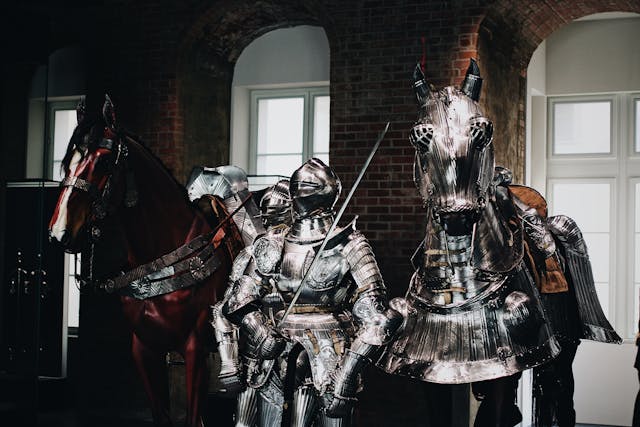
When did knights stop wearing armor? Knights stopped wearing armor when muskets began to be used more widely in battles.
There are many types of armor, and it has evolved over the centuries. We are all familiar with the iron and then steel armor that knights often wear in movies. We have also probably seen the leather and then steel armor that Japanese samurai wore. With this question, we are going to focus on the plate armor worn in Europe.
People have tried to protect themselves for as long as we have been fighting each other. Stone Age people wore thick furs and leather to protect themselves. Bronze Age people made armor out of bronze, and that was enough to protect them against bronze swords. There is always competition with armor and weapons. Armor gets stronger to be able to withstand weapons, so people make stronger weapons. When iron came along, bronze armor was no good, so iron armor was invented. The Romans used chainmail armor over leather. Chainmail is a shirt made of lots of tiny loops of iron. The loops were flexible and could move with a sword, removing its energy and protecting the wearer from the blade. Chainmail was light and very flexible. However, chainmail doesn’t work with iron tipped arrows because they have enough force to break the links open. Roman legionaries also wore laminar armor, which was made from bands of metal tied together in horizontal rows, overlapping each other, almost like fish scales.
Chainmail might have had some drawbacks, but it was light, flexible, and cheaper to make. It used less metal than plates, so it was easier to supply, although it would still have been fairly expensive. Vikings wore chainmail, as did a lot of early Medieval soldiers. They wore thick clothes underneath to protect them from the blows. Chainmail could still be pierced by arrows and spears, though.
In the early Middle Ages, chainmail began to extend down the legs, and then in the 14th century, knights started to wear plates sewn into clothing on top of chainmail. This gradually evolved into full plates of armor. By the 15th century, the suit of armor that we would recognize today was common on the battlefield. Although when I say common, it was common amongst the wealthy knights who could afford it. Armor was very expensive, needed a lot of care, and required a servant to help put it on. The majority of soldiers still wore chainmail or just a chest plate.
Armor was very effective against sword blows, but it did have its downsides. It wasn’t actually as heavy as we think. A full suit of armor might weigh 20 kg, and they were well jointed so people could walk and fight with armor on relatively easily. They were also strong plates and they could protect the wearer against many blows. The problems came because any suit of armor needs joints and these joints are always going to be a weak point. Weapons, such as spears and halberds, were designed to deliver a lot of force to a joint, hopefully piercing it. Heavy weapons like maces were also used because if you could hit the armor hard enough, you could kill the wearer by blunt force trauma. Some powerful crossbows could penetrate plate armor, but they were expensive and took much longer to load than a regular bow and arrow. To counteract arrows and spears, the plate armor was sloped to make the arrow slide off it, rather than hitting it.
Plate armor began to die out as muskets were introduced into warfare. Gunpowder and muskets were introduced into Europe in the 14th century. The early muskets were very slow to load, difficult to aim, and they didn’t have a lot of power. Plate armor would have had no trouble deflecting a musketball in that era, assuming the person with the musket could even hit them. Over the next century, muskets became progressively more powerful and a musketball from those guns could penetrate armor, if fired from not too far away. To counter that, armor became stronger. The metal was heat-treated, which increased its strength. Knights were also helped by the fact that muskets were still expensive and slow to load. In the 16th century and 17th century, muskets improved drastically and became several times more powerful and more common than before. The only way to make armor strong enough to stop a musketball from one of those guns was to make it much thicker. There is a limit to how much weight a knight can wear and that limit was pretty quickly reached. Armor became impractical and, not just that, anyone wearing armor was an obvious target. Suits of armor disappeared fairly quickly. Some soldiers still wore very thick breastplates, even in the Napoleonic wars, but there were no more suits of armor. And this is what I learned today.
Sources
https://en.wikipedia.org/wiki/Plate_armour
https://www.metmuseum.org/essays/arms-and-armor-common-misconceptions-and-frequently-asked-questions
https://www.livescience.com/archaeology/was-medieval-armor-bulletproof
https://en.wikipedia.org/wiki/Laminar_armour
https://www.hurstwic.org/history/articles/manufacturing/text/viking_mail.htm
Photo by Ott Maidre: https://www.pexels.com/photo/medieval-armor-2046779/
